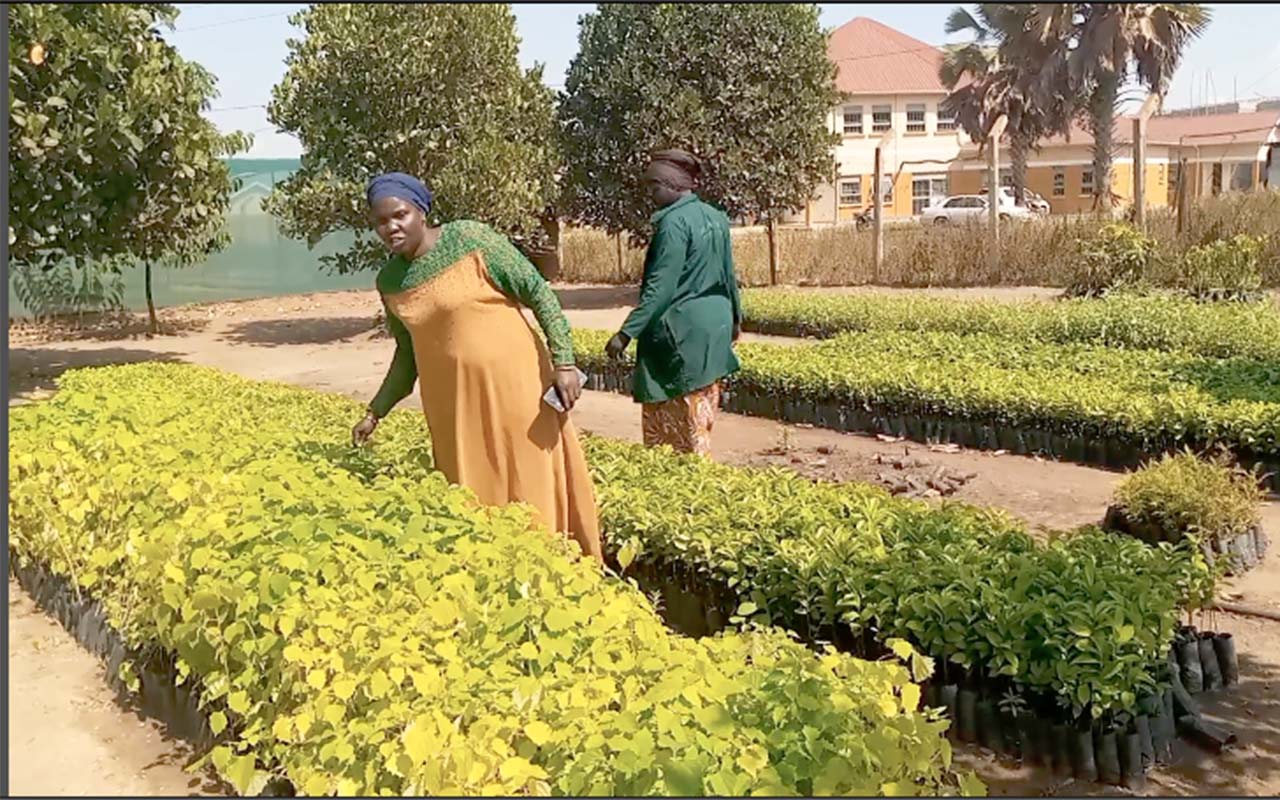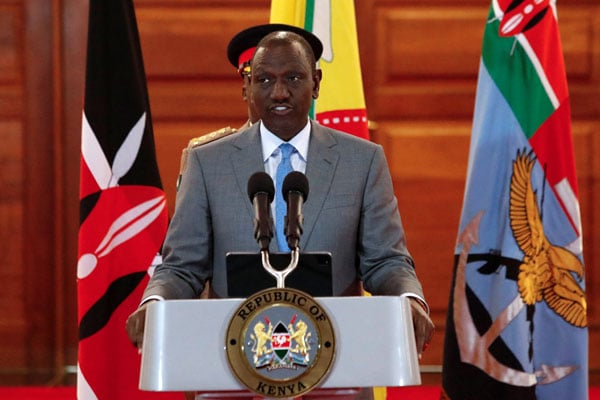West Nile women embrace agroforestry to give degraded forests a break

Alice Chandiru inspecting her nursery bed. Photo/Marko Taibot
What you need to know:
- In the West Nile sub-region, especially in the sub-counties that host refugees, women have unintentionally found themselves to be contributors to environmental degradation and deforestation, simply because they need firewood for cooking or for making charcoal. But as Marko Taibot writes, with more awareness, some are becoming environmental defenders and activists for afforestation.
The high demand for charcoal as a cheaper source of fuel – compared to other alternatives – and the activities of illegal loggers are threatening the very existence of forest reserves in the northern and north western parts of the country
Deforestation not only leads to a gradual change in rain patterns as these regions are experiencing, but the cutting down of trees removes important carbon sinks that could have stored large amounts of carbon dioxide for a long time. Increased carbon in the atmosphere leads to global warming. For instance, a hectare of trees can store 50 tons of carbon, which is the equivalent of 180 tons of carbon dioxide in the atmosphere.
Now, to reverse the trend of deforestation, a cross-section of women in the West Nile sub-region have embarked on agroforestry as a local solution to their fuel and construction needs, as well as a source of extra income.
Since 2016, almost every sub-country in districts such as Adjumani, is hosting a refugee settlement. The arrival of the refugees from South Sudan, put alot of pressure on the forests in the region, as trees were cut down indescriminately to clear land for construction and farming. In more recent years, trees are being cut down for firewood.
The women, who include Margaret Opeli, a peasant farmer, have, with the support of district local governments and partners like the Food and Agricultural Organisation of the United Nations (FAO), planted more than 100 acres of different species of trees to address the increasing demand for firewood and charcoal.
“I have since come to learn that trees were being cut down without replacement. The charcoal trade is not sustainable, unless many people involve themselves in planting trees to replace those which have been cut down,” she says.
Opeli is a resident of Pakwinya village, Itirikwa sub-county, in Adjumani district. In 2020, she and six other women formed a group that planted 15,000 eucalyptus trees on 30 acres of land in Adjumani and Zombo districts. The tree species in these wood fuel plantations grow quickly and can be cut down for firewood and charcoal to ease pressure on the natural forests.
“Today, women are walking long distances away from their homes to collect firewood because all the natural trees around us have been cut down. However, we will be able to harvest trees from our fuelwood plantations by 2025,” she says.
On addressing deforestation, Khemis Ambaga, the forestry officer for Yumbe district, says the depletion of forest cover in his district has been systematic, right from the time when residents returned from exile in 1986.
“In 2016, the refugees from South Sudan were settled in woodlands that had been previously inaccessible. These woodlands were full of natural tree species, and some were part of the cattle corridor. Since then, the percentage of forest cover in the district has drastically reduced to 17.08,” he says.

Some of the women in groups cleaning around their nursery bed. Photo/Marko Taibot
The district local government has now come to the realisation that with the influx of refugees and a growing population, the future is bleak if they do not engage in tree planting,.
“The district council helps us to mobilise the community to get out of the forests to allow regeneration of the trees. We also engage the locals to raise assorted tree species in nursery beds so that anyone can access the seedlings. The FAO has 24 farmers who will be paide to plant fuelwood tree species in the area,” Ambaga adds.
He says with the help of the central government, the district intends to establish permanent nursery beds from which residents will access seedlings free-of-charge. They will also have access to extension workers who will help with the planting process.
Josephine Masudio, a tree farmer in Zoka Central village, Itirikwa sub-county, in Adjumani district, says she took up the project because she is passionate about tree planting and management.
“I have a number of tree species on my farm. I have eucalyptus clones on six acres, mahogany, ashoka and teaks on 14 acres, 82 cocoa trees, 60 musk trees, three acres of coffee, 40 macadamia trees, and other fruit trees. In total, I have 30,000 trees. I appeal to all families which own excess land to plant at least 1,000 trees per acre to enhance their livelihoods and combat climate change,” she says.
Francis Ojja, the forest officer for Adjumani district, says previously, over 25 percent of the district’s 31,000 square kilometres was forest cover. However, 50 percent have since been destroyed as a result of refugees’ arrival, rapid urbanisation, and illegal logging.
“There is lawlessness because of the conflict (Apaa) in the southern part of the district, which is the Zoka Upper Belt. It has attracted a number of immigrants leading to a significant loss of forest cover.
There are efforts by the government and partners to reverse this trend by supporting communities to have woodlots. However, our technical team finds it difficult to access these places because the communities are hostile, despite the presence of security officers. We cannot monitor and regulate activities in the Zoka belt,” he says.
The district has a target of planting 500 acres of trees, a project that is being funded by UNHCR in partnership with the National Forest Authority (NFA).
“Last year, we planted 318 acres but this year, we should be doing better because we have more seedlings. We now have a nursery bed at the district headquarters and we encourage farmers to pick seedlings free of charge,” Ojja says.

Ms Rose in her forest that is one year old. Photo/Marko Taibot
Lifestyle changes through afforestation
In 2017, Alice Chandiru, a resident of Wolo Parish, Odravu sub-county, in Yumbe district, formed a group of 15 women and started a project of raising tree seedlings.
“In this project, we have two interests – alleviating poverty by selling the seedlings and planting trees to conserve the environment. Our biggest challenge is that women are not allowed to own land. We were planting on land that belonged to a man. We had planted fruit trees and woodlots, but he evicted us after two years,” she says.
The group bought a piece of land measuring 75x75 on which to raise their seedlings. They also decided that each woman should hire two acres of land to plant a wood fuel plantation. The plantations are also demonstration farms where every three months, the women educate people from different communities about reforestation.
“When we sell off the seedlings, we divide the proceeds in three ways – for purchasing seedlings from a verified seed centre, maintaining the seedlings, and then we use the rest to pay school fees for our children. Among our children, we have a medical student, nursing students, and a fine artist. We all contribute to their education,” she says.
The women’s lifestyle has also changed in a positive way. However, they face huge competition in the market because there are now many women groups practicing agroforestry.
“In 2021, we made sales worth Shs20 million and in 2022, we made Shs15 million. Last year, our proceeds reduced to Shs10 million. So far, this year we have had extreme dry and hot weather and our seedlings are struggling,” Chandiru says.
Amos Ongwen the manager for environment and energy for West Nile at Dan Church Aid, says reforestation efforts focus on women because they are the major degraders of the environment.
“Due to their roles in the home, it is mostly women who cut down trees for firewood. Besides the local residents, we are also engaging female refugees to plant fruit and shade trees in woodlots. We pay them to carry out the clearing, lining and planting. We encourage them to practice agroforestry in the woodlots, and as they tend their crops, they help us maintain the trees,” he says.
Dan Church Aid started the woodlots in 2019 and so far, the organisation has planted more than four million trees on 4,300 hectares of land.
Sustainable charcoal value chain
The Nationally Appropriate mitigation Action Study on Sustainable Charcoal in Uganda indicates that the demand for charcoal in Uganda is about 2.3 million tonnes per year and could increase at 4.2 percent annually. It further elaborates that 65 percent of urban households rely on charcoal as their energy source, adding that access to clean energy alternatives is generally low. Greenhouse gas emissions from the charcoal value chain account for 6.7 percent of the national green house gas emissions. By 2030, emissions from the charcoal value chain may account for up to 35 percent of Uganda’s total green house gas emissions if no action is taken to improve the charcoal value chain.
As a mitigation measure, besides reforestation, the districts in West Nile and their partners are facilitating the construction of casamance kilns that use efficient technology to cut down on the amount of firewood used for making charcoal.
Funded by the European Union, the project is an intervention of the Government of Uganda, implemented by FAO in collaboration with the Ministry of Energy and Mineral Development and the Ministry of Water and Environment.
“This is an improved technology away from the usual earth-mound kilns and we are talking to the farmers who convert the wood on their farms to charcoal to adopt these technologies. In fact, we shall try to bring this to the district council so that it becomes an ordinance that whoever is going to convert wood to charcoal should use this technology,” Ojja says.
Charcoal production in Uganda predominantly uses rudimentary technology (earth-mound kilns) with low conversion rates ranging from 10 to 15 percent. As a result, more wood is required to produce a single unit of charcoal and about 90 percent of the wood is wasted during the conversion process.
“The project will subsidise the acquisition of 200 casamance kilns. Using improved casamance kilns is expected to enhance the efficiency of wood to charcoal conversion from 10 percent currently to 35%.” Ojja adds.
Ongwen says besides maintaining the woodlots, the refugee women are engaged in the construction of the Lorena energy cook stoves that use small amounts of firewood.
“Since 2019, we have constructed 43,000 stoves and because they use less firewood, this translates to environmental conservation because if households have access to these stoves, they will spend less time in the forests looking for firewood,” he says.
He adds that because of their heat retention capabilities, the stoves have reduced the amount of firewood a family uses by 70 percent. A woman can use only two pieces of firewood to prepare a meal, where previously, she was using ten pieces.
The gaps in the charcoal value chain
The Ministry of Water and Environment (MWE) and the Ministry of Energy and Mineral Development (MEMD) are the main institutions with the mandate to regulate the charcoal value chain. However, limited coordination between the government agencies creates avenues for illegalities and malpractices.
The United Nations Development Program (UNDP) estimates that Uganda losses up to USD 72.7 million in foregone taxes and licensing fees from charcoal production and trade. Biomass energy contributes 88% of the total primary energy consumed by the population.
Given the price of alternatives such as, gas and electricity in the short to medium term, charcoal and firewood will continue to play a significant role in meeting the energy needs of Ugandan’s growing population and the refugees.




